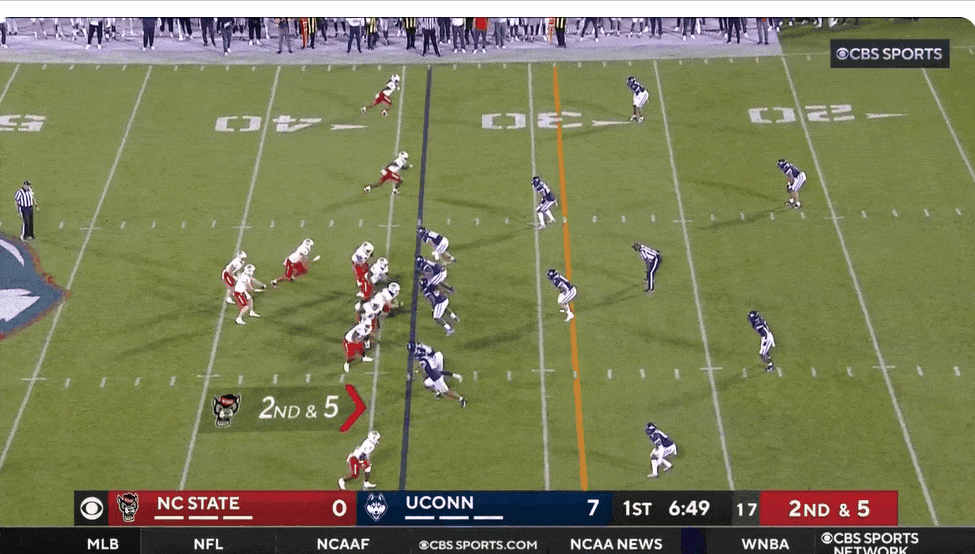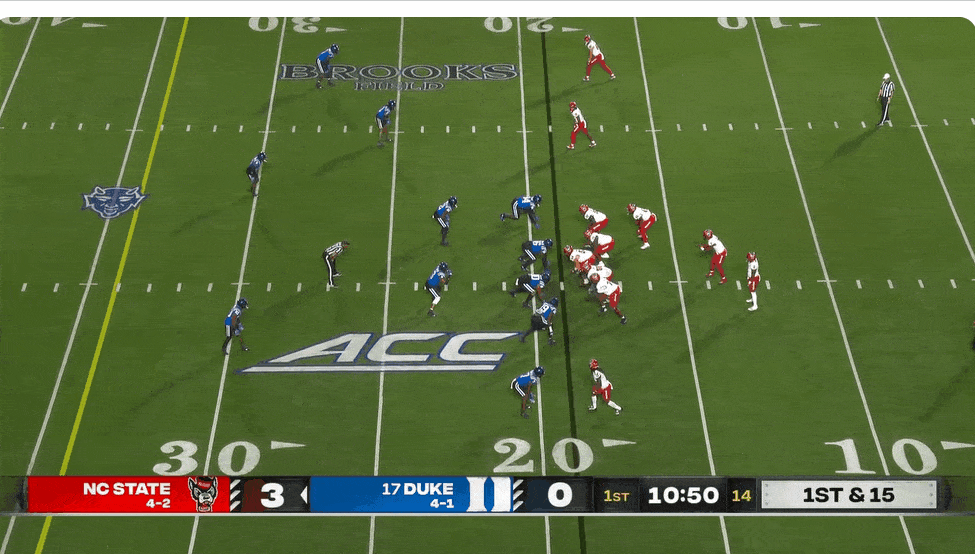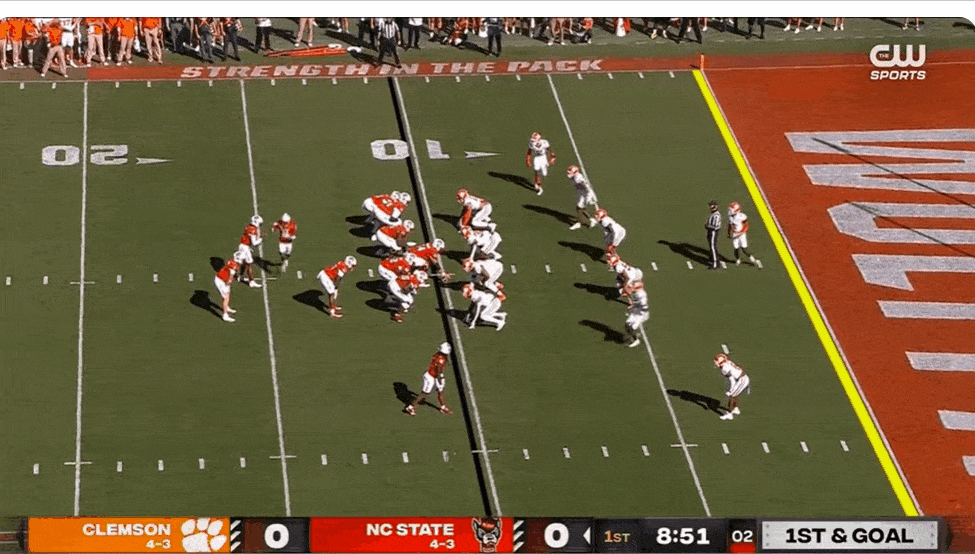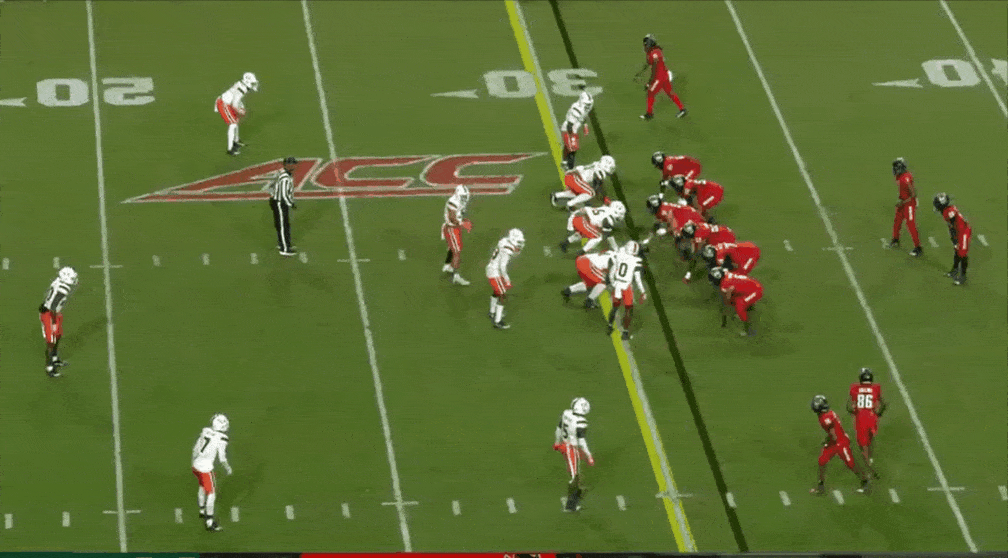A largely ineffective ground game has been an unfortunate feature of the NC State offense for a number of years now, and by and large, 2023 has offered no reprieve. Now, State did just have its best rushing game of the season against Wake Forest and its run game has been evolving all year. The concepts have changed, the carries have changed, the formations have changed, and State has continued to try and manufacture a ground game with as much creativity as it can muster. It has worked to create some explosives, but State still struggles to produce with base run concepts, and it can be hard to build your offense out when you can't run base run concepts.
It’s easy to say it just can’t block. I’ve personally fallen into this trap, and certainly, it has not been a run blocking clinic from the Wolfpack, but there’s more to it than that. The line has improved as the year has gone on, and Wake Forest was its strongest run blocking performance of the year. It's getting better, and that's good. It's combined general unit improvement on the offensive line with some personnel shuffling, and it helped produce 266 rushing yards against the Demon Deacons, a season-high.
The Pack needed more from its offensive line, and it's starting to get it. It needed more from its backs, and the verdict is still out on that. The Pack's backfield has struggled with small area quickness and vision. It needs more pop and better decision making from the backfield. This is where the usage boost for Kevin Concepcion as a runner and Kendrick Raphael are coming from. These guys have more burst, and when they make good reads, it can spring big plays.
As mentioned, things have been evolving for the Pack. Phillip Danford of Inside Pack Sports charted the different concepts State has used here in the first 5 games versus the next 4 (this is pre-Wake).
By the way, if you’re not currently watching Danford and Alex Gee’s weekly IPS feature, The Walk-Through, it’s fantastic and you should be. If you enjoy any of the film review we do here, they take it to a whole different level there.
Regardless of the concepts, they require execution, and we're going to take a look at where some of this stuff has gone wrong, and then we'll end with some stuff that has gone right. First, we’re going to take a look at an outside zone play that State blocks relatively well, but it goes for a loss because of a poor read from a running back. Zone by default puts more weight on the decision-making and burst of the running back than your gap scheme plays do. Bad vision or a slow cut from a running back will turn a well-blocked play into a loss. To run zone as a back, you need to be patient but decisive, quick in your cuts, and explosive. State’s primary runners have lacked a bit at times, and it’s resulted in some failed zone runs through no fault of the line.
On an outside zone play, Your linemen are reach blocking the player in their play-side gap. The goal of a reach block is to seal the defender to the backside by targeting his outside shoulder and blocking him away from the play. Fundamentally, outside zone is a play ran to the edge, with the running back trying to get to the outside of the tackle. If a lineman is unable to reach their defender, that block can convert to a drive block, which means they’re now trying to drive the defender toward the play side.
Outside zone is effective because it allows the blockers to react to what the defenders do. It is easier to gain leverage, and it creates cutback lanes for the back. Outside zone makes it to the edge on less than probably 20% of plays. The real goal is to force the defense to respect the edge and create these cutback lanes. State used to run outside zone until it was blue in the face with Eliah Drinkwitz and Dwayne Ledford, and it was pretty good at it. The run scheme now has a lot more gap scheme plays in it under Anae, but it still runs a fair amount of zone.

The only player on the line here who is not reach blocking will be Tim McKay at right tackle. When you have a defensive end lined up way outside in what is called a 9-technique (or in this case a ghost 9-technique), like Duke is doing here, that player is unreachable and that block converts to a kick out block. Allen as the running back is reading the blocking leverage from the right side, or play side, inward. Pre-snap, he should know that the end will be kicked out, which means getting outside Tim McKay is not going to happen.
When the right tackle’s block gets turned outside, as it does here automatically when it converts to a kick out, Allen reads down the line to the next defender. To put it simply, what he’s looking for is a seal to the inside. When he reads a defender with outside leverage, and then comes down the line and reads a defender who is sealed to the inside, that’s a hole, and that’s where he cuts. Let’s see what goes wrong here.

It’s not the greatest kick out block by McKay, but it should be good enough. Eason and McMahon double the defensive tackle before Eason releases up the field to the linebacker. McMahon does an awesome job reaching here and creating a seal, and Eason is in position to block the linebacker. The read for Allen is the B gap, and this thing has a chance to be a nice play.
I don’t know what Allen saw here, but he cuts this back one defender too far.

McMahon has successfully reached the nose tackle, but Allen is already cutting to his third read, which is inside of the second defensive lineman. He ends up cutting directly into where the nose tackle is blocked, and he has to cut back across the formation and improvise a bit. McMahon's seal develops a little slower than the back side block. Perhaps Allen reads this play too fast. I don't know exactly what happened, but this is not a poorly blocked play. It's poorly ran from the back, and it could spring if Allen explodes to his second read inside of McKay.
This is, of course, hilarious to critique from a chair with a paused YouTube video. When this stuff happens on the field, it happens at a 1000 MPH, and the consequence for a bad decision is a 300-pound guy landing on you. This isn't some colossal mistake from Allen. He likely just needed a tick more patience here.
For comparison’s sake, here’s a play that develops in a similar way minus the release from the right guard, and Jordan Houston makes the right read.

Here’s a counter play. A counter play is a gap scheme play, which is fundamentally different from zone. State operates with a decent distribution of both concepts, and this is G/H Counter with Allen as the running back. Carter is the right guard here and Peak is the H, both are labeled below. What’s supposed to happen here is Carter and Peak pull across the formation, Carter seals inside while Peak kicks out the outside defender, creating a running lane in between them. The left tackle and left guard double team the defensive tackle with a down block and wash toward the back side of the play. It can create multiple running lanes depending on the blocks of the pullers. If ran perfectly, the back hits between the H and the G and is one-on-one with a defensive back as the player filling in the gap.

This is an extremely well-blocked play.

Duke stunts the defensive tackle, which puts them in a bad spot as State doesn’t need to down block him. It helps create a huge hole and a block on the linebacker for Belton. Anthony Carter demolishes the linebacker to seal him inside, and Peak executes his kickout. There is a lot of space here. Allen hits it but then tries to take this outside of Lesane’s block at the second level. He should be cutting this back inside, where he’ll be one on one with the safety, and if he wins he’s going to score a touchdown. This is a great downfield block from Lesane to spring this. I’m not sure what Allen saw here, but he runs toward the unblocked corner and tries to beat him to the sideline instead. It’s a five yard gain.

(This isn't just crap-on-Michael-Allen hour by the way. Other backs have done this too. I think Raphael is the best back, but I noted one from him in my Wake Forest analysis.)
The offensive line is the most important part of a run play, but it's far from the only thing that can kill a play. State hasn't been an elite run blocking team, but it's also struggled to maximize blocking when it has been good. It's really a combination of things, all of which State has spent the season developing solutions for. Let's take a look at some examples from earlier in the season where the blocking fell apart for State, and then a few from Saturday's win over Wake where it came together.
First, an inside zone play from the Duke game.

Inside zone and outside zone can sometimes look similar, but the fundamental difference is that the line is trying to generate more vertical movement on the play side. It is not trying to seal to the backside or drive toward the sideline. This play is well blocked on the front side. McMahon and Cooper double team the nose tackle and drive him toward the mike linebacker, Cooper can overtake the block and McMahon can release to the backer. It's a light box, and when the play-side defensive end gets thrown outside by McKay, State gets Carter as a free blocker up the field. This one has a chance to break open, but it gets exploded on the back side.
Duke brings a run blitz from the back side, and it’s Belton’s responsibility to pick this up. He loses the edge and allows the penetration, and the blitz cuts off the original track for the running back. It disrupts the timing of the play entirely and Raphael has to cut underneath, where he runs into the back side pursuit and loses yards.

The front side of this play is developing really well. Raphael is getting to the DBs if he doesn't have to cut back. He has no chance though. Penetration will blow up a zone play. That’s what happened here.
This is outside zone. Note the blockers trying to attack the outside shoulder of the defenders.

Allen reads this one correctly, but Anthony Carter loses. Just as in the Duke example at the top, there is a 9-technique defensive end here, and Belton throws him outside. McMahon at center releases to the linebacker and gets him turned inside. Carter at left guard tries to reach the defensive end (#97), but cannot gain outside leverage, so he switches and tries to throw him outside. Allen reads all of this right and takes his third read to the inside of the defensive tackle, but Carter cannot throw 97 outside. He ends up falling, and 97 is right there in the hole unblocked.

If Carter succeeds in throwing this guy outside, it’s a 10-15 yard gain. He loses though.
This is another G/H Counter, this time with Armstrong as the running back. McKay is the right guard here and Toudle is the H.

State gets a great push on the defensive tackle, and Toudle does a good enough job on the inside, but McKay gets beat on the kick out block. What this does is it allows the defensive end to squeeze the play down and it makes the fill-defender’s job much easier. This is a two-yard gain, but if McKay kicks out this defensive end, it’s Armstrong and the DB alone with a lot more space for the QB/RB/grown-ass-man than what you see below.

A good run play features a combination of successes, which State has not been able to put together regularly enough. It is not purely bad blocking, though. This offensive line unit hasn’t been great, but it’s taken more heat than it has deserved. With Armstrong back in the fold and a growing role for Kendrick Raphael, the run concepts may have a little more juice. State’s built a lot of misdirection into its base concepts with Concepcion, pre-snap motions, and general eye candy that forces the defense to stay disciplined and communicate. Concepcion and Raphael seem to have the most pop and explosion to the cuts, and that helps a lot. Armstrong being who he is also helps because it evens out box counts and can hold backside pursuit on run plays with read concepts that State didn’t really run much of with Morris. State’s already creative, and a lot of room for creativity exists down the stretch here. It helped beat Wake Forest, as did one of the best running blocking games of the year. Let's take a look at some recent successes.
Let's start with the play that clinched the Miami game. This is inside zone.

Remember the run blitz example from earlier that blew up an inside zone play? This play faces a similar blitz from number 0, but Pennix prevents the penetration. The aiming point for Raphael is most likely to the right of the center, but he cuts to daylight on the backside when Pennix and Belton drive down the defense. The block from Pennix is just so good. This also comes with a bit of creativity. The pre-snap motion from Dacari Collins creates an additional gap that the defense never adjusts to, which is exactly where the daylight ends up being.
Here's a play called Down G, which involves the play side guard pulling and executing a kick out block, while the back side of the offensive line blocks like its inside zone. There are variations, but that's what this is, and it's really well executed.

Anthony Carter is the play-side guard, and he does a great job kicking out the defensive end. State runs this from a heavy formation with two tight ends, one of which is Peak on the play side. Belton and Peak double team the defensive tackle, and then Peak is able to work his body into the linebacker and disrupt his flow. Wake's defense seems to originally diagnose this as inside zone, which causes the second level of the defense to stay back side of the play, and it helps Peak, who is engaged in a double team, block the linebacker who thinks he's in his gap. The zone blocking on the back side can throw off a defense's ability to diagnose the play quickly, and when the o-line dominates on the front side like it does here, everything is swell and you're off to the races.
The blocking has improved for State, and the run game's variety and play design has helped. Wake also isn't the defense that Miami, Clemson, and Duke were, so a lot of things started to look better. State will need to be able to run the ball in these final two games. I have no idea if it will be able to do that, but with a growing workload for Raphael and Concepcion, Armstrong in the fold, and a line that is playing better, it's certainly in a better spot than it used to be.
.png)
Love it! Great work as always. I get emails when y'all have a new post, but half the time when I click it says "post does not exist" or some such thing (most recently with the Yes, Virginia thing on KKIAW's offense. What up wit dat?